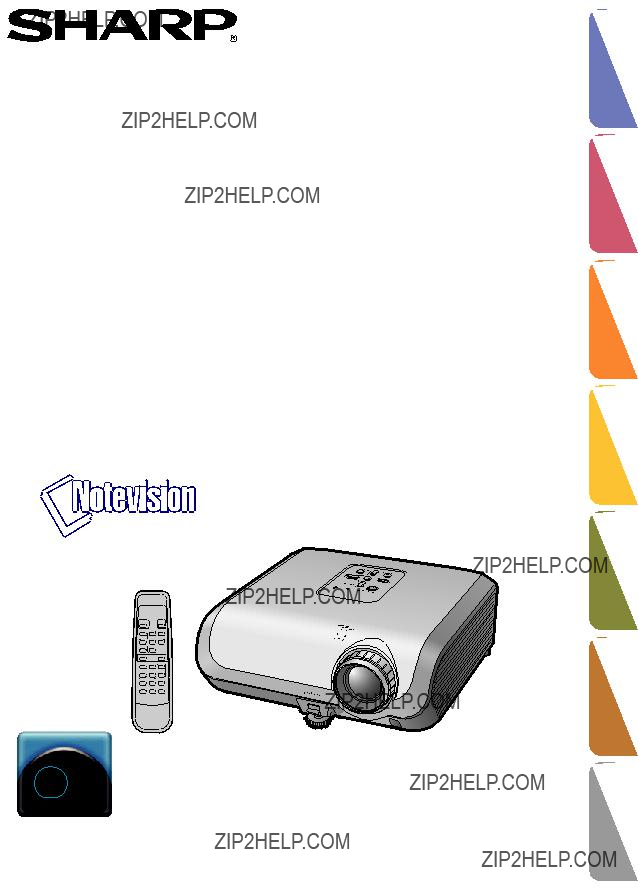
MULTIMEDIA PROJECTOR
MODEL
OPERATION MANUAL

MULTIMEDIA PROJECTOR
MODEL
OPERATION MANUAL

IMPORTANT
???For your assistance in reporting the loss or theft of your Projector, please record the Model and Serial Number located on the bottom of the projector and retain this information.
???Before recycling the packaging, please ensure that you have checked the con- tents of the carton thoroughly against the list of ???Supplied accessories??? on page 10.
Model No.:
Serial No.:
SPECIAL NOTE FOR USERS IN THE U.K.
The mains lead of this product is fitted with a  or
or  and of the same rating as above, which is also indicated on the pin face of the plug, must be used.
and of the same rating as above, which is also indicated on the pin face of the plug, must be used.
Always refit the fuse cover after replacing the fuse. Never use the plug without the fuse cover fitted.
In the unlikely event of the socket outlet in your home not being compatible with the plug supplied, cut off the mains plug and fit an appropriate type.
DANGER:
The fuse from the
Under no circumstances should the
To fit an appropriate plug to the mains lead, follow the instructions below:
WARNING:
THIS APPARATUS MUST BE EARTHED.
IMPORTANT:
The wires in this mains lead are coloured in accordance with the following code:
As the colours of the wires in the mains lead of this apparatus may not correspond with the coloured markings identifying the terminals in your plug proceed as follows:
???The wire which is coloured  or coloured green or
or coloured green or
???The wire which is coloured blue must be connected to the terminal which is marked with the letter N or coloured black.
???The wire which is coloured brown must be connected to the terminal which is marked with the letter L or coloured red.
IF YOU HAVE ANY DOUBT, CONSULT A QUALIFIED ELECTRICIAN.
ii

iii

The supplied
Die mitgelieferte
Le
Den medf??ljande
El
Il
De meegeleverde
O
iv
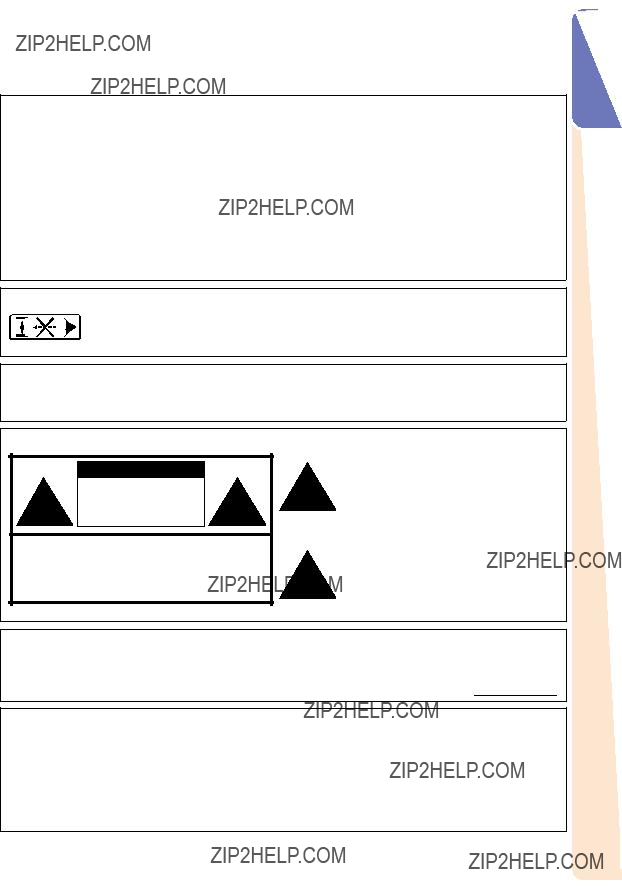
Before using the projector, please read this operation manual carefully.
There are two important reasons for prompt warranty registration of your new SHARP Projector, using the REGISTRATION CARD packed with the projector.
1.WARRANTY
This is to assure that you immediately receive the full benefit of the parts, service and labor warranty applicable to your purchase.
2.CONSUMER PRODUCT SAFETY ACT
To ensure that you will promptly receive any safety notification of inspection, modification, or recall that SHARP may be required to give under the 1972 Consumer Product Safety Act, PLEASE READ CAREFULLY THE IMPORTANT
WARNING: High brightness light source. Do not stare into the beam of light, or view  directly. Be especially careful that children do not stare directly into the beam of light.
directly. Be especially careful that children do not stare directly into the beam of light.
WARNING: To reduce the risk of fire or electric shock, do not expose this product to rain or moisture.
Introduction
See bottom of projector.
The lightning flash with arrowhead sym- bol, within an equilateral triangle, is in- tended to alert the user to the presence of uninsulated ???dangerous voltage??? within the product???s enclosure that may be of sufficient magnitude to constitute a risk or electric shock to persons.
The exclamation point within a triangle is intended to alert the user to the presence of important operating and maintenance (servicing) instructions in the literature accompanying the product.
WARNING: FCC Regulations state that any unauthorized changes or modifications to this equipment not expressly approved by the manufacturer could void the user???s authority to operate this equipment. 

WARNING:
The cooling fan in this projector continues to run for about 90 seconds after the projector enters standby mode. During normal operation, when putting the projector into standby mode always use the STANDBY/ON button on the projector or the STANDBY button on the remote control. Ensure the cooling fan has stopped before disconnecting the power cord.
DURING NORMAL OPERATION, NEVER TURN THE PROJECTOR OFF BY DISCONNECTING
THE POWER CORD. FAILURE TO OBSERVE THIS WILL RESULT IN PREMATURE LAMP FAILURE.
1

INFORMATION
This equipment has been tested and found to comply with the limits for a Class B digital device, pursuant to Part 15 of the FCC Rules. These limits are designed to provide reasonable protection against harmful interference in a residential installation. This equipment generates, uses, and can radiate radio frequency energy and, if not installed and used in accordance with the operation manual, may cause harmful interference to radio communications. However, there is no guarantee that interference will not occur in a particular installation. If this equipment does cause harmful interference to radio or television reception, which can be determined by turning the equipment off and on, the user is encouraged to try to correct the interference by one or more of the following measures:
???Reorient or relocate the receiving antenna.
???Increase the separation between the equipment and the receiver.
???Connect the equipment into an outlet on a circuit different from that to which the receiver is connected.
Declaration of conformity
SHARP PROJECTOR, MODEL
This device complies with Part 15 of the FCC rules. Operation is subject to the following conditions: (1) This device may not cause harmful interference, and (2) this device must accept any interference received, including interference that may cause undesired operation.
PRODUCT DISPOSAL
This projector utilizes
Caution Concerning Lamp Replacement
See ???Replacing the Lamp??? on page 50.
This SHARP projector uses a DMD panel. This very sophisticated panel contains 786,432 (XG-
This unit has some inactive pixels within acceptable tolerances which may result in inactive dots on the picture screen. This will not affect the picture quality or the life expectancy of the unit.
2

How to Read this Operation Manual
???The specifications are slightly different, depending on the model. However, you can connect and operate all models in the same manner.
???In this operation manual, the illustration and the screen display are simplified for explanation, and may differ slightly from the actual display.
Using the Menu Screen
ENTER button
Adjustment buttons (P/R/O/Q)
 Info ........Indicates safeguards for using the projector.
Info ........Indicates safeguards for using the projector.
Note .........Indicates additional information for setting up and operating the projector.
For Future Reference
Introduction
3

4

Reference
Introduction
5

IMPORTANT SAFEGUARDS
CAUTION: Please read all of these instructions before you operate this product and save these instructions for later use.
Electrical energy can perform many useful functions. This product has been engineered and manufactured to assure your personal safety. BUT IMPROPER USE CAN RESULT IN POTENTIAL ELECTRICAL SHOCK OR FIRE HAZARDS. In order not to defeat the safeguards incorporated in this product, observe the following basic rules for its installation, use and servicing.
1.Read Instructions
All the safety and operating instructions should be read before the product is operated.
2.Retain Instructions
The safety and operating instructions should be retained for future reference.
3.Heed Warnings
All warnings on the product and in the operating instructions should be adhered to.
4.Follow Instructions
All operating and use instructions should be followed.
5.Cleaning
Unplug this product from the wall outlet before cleaning. Do not use liquid cleaners or aerosol cleaners. Use a damp cloth for cleaning.
6.Attachments
Do not use attachments not recommended by the product manufacturer as they may cause hazards.
7.Water and Moisture
Do not use this product near
8.Accessories
Do not place this product on an unstable cart, stand, tripod, bracket, or table. The product may fall, causing serious injury to a child or adult, and serious damage to the product. Use only with a cart, stand, tripod, bracket, or table recommended by the manufacturer, or sold with the product. Any mounting of the product should follow the manufacturer???s instructions, and should use a mounting accessory recommended by the manufacturer.
9.Transportation
A product and cart
combination should be moved with care. Quick stops, excessive force, and uneven surfaces may cause the product and cart combination to overturn.
10.Ventilation
Slots and openings in the cabinet are provided for ventilation to ensure reliable operation of the product and to protect it from overheating, and these openings must not be blocked or covered. The openings should never be blocked by placing the product on a bed, sofa, rug, or other similar surface. This product should not be placed in a
11.Power Sources
This product should be operated only from the type of power source indicated on the marking label. If you are not sure of the type of power supply to your home, consult your product dealer or local power company. For products intended to operate from battery power, or other sources, refer to the operating instructions.
12.Grounding or Polarization
This product is provided with one of the following types of plugs. If the plug should fail to fit into the power outlet, please contact your electrician.
Do not defeat the safety purpose of the plug.
a.
b.
This plug will only fit into a grounding type power outlet.
13.
14.Lightning
For added protection for this product during a lightning storm, or when it is left unattended and unused for long periods of time, unplug it from the wall outlet and disconnect the cable system. This will prevent damage to the product due to lightning and
6

15.Overloading
Do not overload wall outlets, extension cords, or integral convenience receptacles as this can result in a risk of fire or electric shock.
16.Object and Liquid Entry
Never push objects of any kind into this product through openings as they may touch dangerous voltage points or
17.Servicing
Do not attempt to service this product yourself as opening or removing covers may expose you to dangerous voltage or other hazards. Refer all servicing to qualified service personnel.
18.Damage Requiring Service
Unplug this product from the wall outlet and refer servicing to qualified service personnel under the following conditions:
a.When the
19.Replacement Parts
When replacement parts are required, be sure the service technician has used replacement parts specified by the manufacturer or have the same characteristics as the original part. Unauthorized substitutions may result in fire, electric shock, or other hazards.
20.Safety Check
Upon completion of any service or repairs to this product, ask the service technician to perform safety checks to determine that the product is in proper operating condition.
21.Wall or Ceiling Mounting
This product should be mounted to a wall or ceiling only as recommended by the manufacturer.
22.Heat
This product should be situated away from heat sources such as radiators, heat registers, stoves, or other products (including amplifiers) that produce heat.
Introduction
b.If liquid has been spilled, or objects have fallen into the product.
c.If the product has been exposed to rain or water.
d.If the product does not operate normally by following the operating instructions. Adjust only those controls that are covered by the operating instructions, as an improper adjustment of other controls may result in damage and will often require extensive work by a qualified technician to restore the product to normal operation.
e.If the product has been dropped or damaged in any way.
f.When the product exhibits a distinct change in performance, this indicates a need for service.
???DLP\ (Digital Light Processing) and DMD\ (Digital Micromirror Device) are trademarks of Texas Instruments, Inc.
???Microsoft?? and Windows?? are registered trademarks of Microsoft Corporation in the United States and/or other countries.
???PC/AT is a registered trademark of International Business Machines Corporation in the United States.
???Adobe?? Reader?? is a trademark of Adobe Systems Incorporated.
???Macintosh?? is a registered trademark of Apple Computer, Inc. in the United States and/or other countries.
???All other company or product names are trademarks or registered trademarks of their respective companies.
???Some IC chips in this product include confidential and/or trade secret property belonging to Texas Instruments. Therefore you may not copy, modify, adapt, translate, distribute, reverse engineer, reverse assemble or discompile the contents thereof.
7
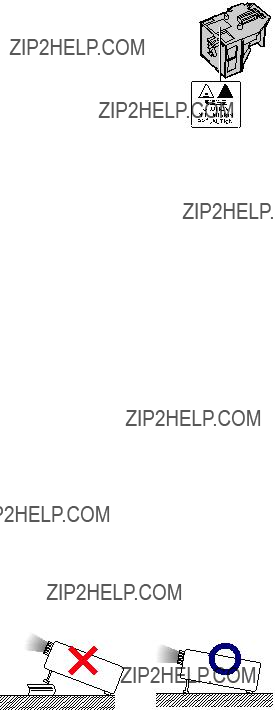
Observe the following safeguards when setting up your projector.
Caution concerning the lamp unit
??? Potential hazard of glass par- ticles if lamp ruptures. In case of lamp rupture, contact your nearest Sharp Autho- rized Projector Dealer or Ser- vice Center for replacement.
See ???Replacing the Lamp??? on page 50.
Caution concerning the setup of the pro- jector
???For minimal servicing and to maintain high image quality, SHARP recommends that this projector be installed in an area free from humidity, dust and cigarette smoke. When the projector is subjected to these environments, the vents and lens must be cleaned more of- ten. As long as the projector is regularly cleaned, use in these environments will not reduce the overall operation life of the unit.
Internal cleaning should only be performed by a Sharp Authorized Projector Dealer or
Service Center.
When using the projector in
???When you use the projector in
Warning about placing the projector in a high position
???When placing the projector in a high position, ensure that it is secured carefully to avoid per- sonal injury caused by the projector falling down.
Do not subject the projector to hard im- pact and/or vibration.
???Protect the lens so as not to hit or damage the surface of the lens.
Rest your eyes occasionally.
???Continuously watching the screen for long hours will cause eye strain. Be sure to occa- sionally rest your eyes.
Do not set up the projector in places ex- posed to direct sunlight or bright light.
???Position the screen so that it is not in direct sunlight or room light. Light falling directly on the screen washes out the colors, making viewing difficult. Close the curtains and dim the lights when setting up the screen in a sunny or bright room.
Caution regarding placing of the projec- tor
???Place the projector on a level site within the adjustment range (8 degrees) of the adjust- ment foot.
Avoid locations with extremes of tem- perature.
???The operating temperature of the projector is from 41??F to 95??F (+5??C to +35??C).
???The storage temperature of the projector is from
Do not block the exhaust and intake vents.
???Allow at least 11 13/16 inches (30 cm) of space between the exhaust vent and the nearest wall or obstruction.
???Be sure that the intake vent and the exhaust vent are not obstructed.
???If the cooling fan becomes obstructed, a pro- tection circuit will automatically put the pro- jector into standby mode to prevent overheat damage. This does not indicate a malfunc- tion. (See pages 48 and 49.) Remove the pro- jector power cord from the wall outlet and wait at least 10 minutes. Place the projector where the intake and exhaust vents are not blocked, plug the power cord back in and turn on the projector. This will return the projector to the normal operating condition.
8
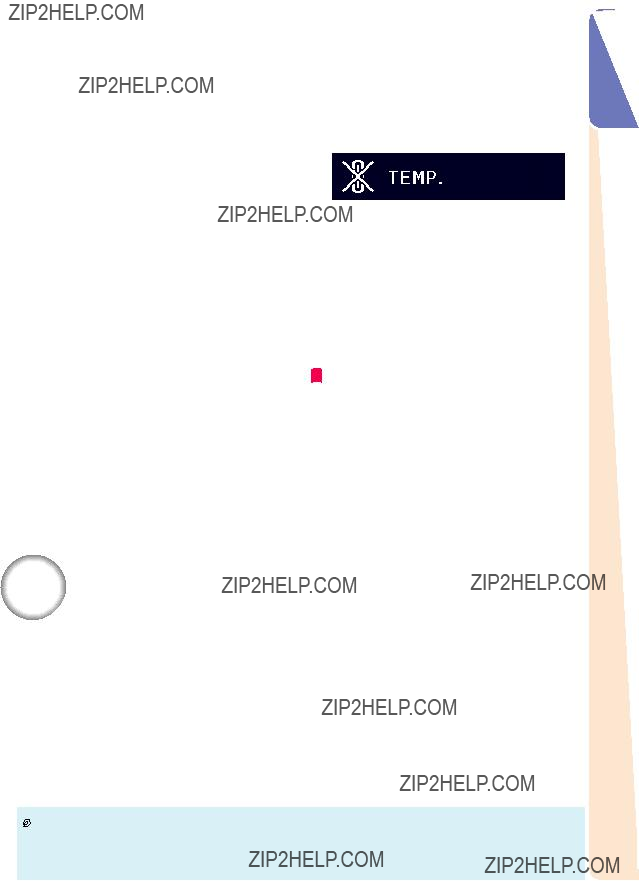
???When turning off the projector, the cooling fan runs to decrease the internal temperature for a while. Unplug the power cord after the cool- ing fan stops. The period the cooling fan runs will vary, depending on the circumstances and the internal temperature.
Caution regarding usage of the projector
???When using the projector, be sure not to sub- ject it to hard impact and/or vibration, as this can result in damage. Take extra care with the lens. Before moving the projector, be sure to unplug the power cord from the wall outlet, and disconnect any other cables connected to it.
???Do not carry the projector by holding the lens.
???When storing the projector,
???Do not expose the projector to direct sunlight or place next to heat sources. Doing so may affect the cabinet color or cause deformation of the plastic cover.
Using the projector in other countries
???The power supply voltage and the shape of the plug may vary depending on the region or country you are using the projector in. When using the projector overseas, be sure to use an appropriate power cord for the coun- try you are in.
Temperature monitor function
???If the projector starts to overheat due to setup
problems or blockage of the air vents, ??? ??? and
??? and
??? ??? will illuminate in the lower left corner of the picture. If the temperature continues to
??? will illuminate in the lower left corner of the picture. If the temperature continues to
rise, the lamp will turn off, the temperature warn- ing indicator on the projector will blink, and after a
Introduction
Other connected equipment
???When connecting a computer or other audio- visual equipment to the projector, make the connections AFTER unplugging the power cord of the projector from the AC outlet and turning off the equipment to be connected.
???Please read the operation manuals of the pro- jector and the equipment to be connected for instructions on how to make the connections.
 Info
Info
???The cooling fan regulates the internal tem- perature, and its performance is automatically controlled. The sound of the fan may change during projector operation due to changes in the fan speed.This does not indicate malfunc- tion.
???Do not unplug the power cord during projec- tion or cooling fan operation. This can cause damage due to rise in internal temperature, as the cooling fan also stops.
How to Access the PDF Operation Manuals
PDF operation manuals in several languages are included in the
Please download Adobe?? Reader?? from the Internet (http://www.adobe.com).
Accessing the PDF Manuals for Windows?? (For Macintosh??, skip step 2).
 Note
Note
???If the desired pdf file cannot be opened by double clicking the mouse, start Adobe?? Reader?? first, then specify the desired file using the ???File???, ???Open??? menu.
9

Accessories
Supplied accessories
(Only supplied with
*Use the power cord that corresponds to the wall outlet in your country.
???Operation manual (this manual
Optional accessories
 Note
Note
???Some of the optional accessories may not be available depending on the region. Please check with your nearest Sharp Authorized Projector Dealer or Service Center.
10
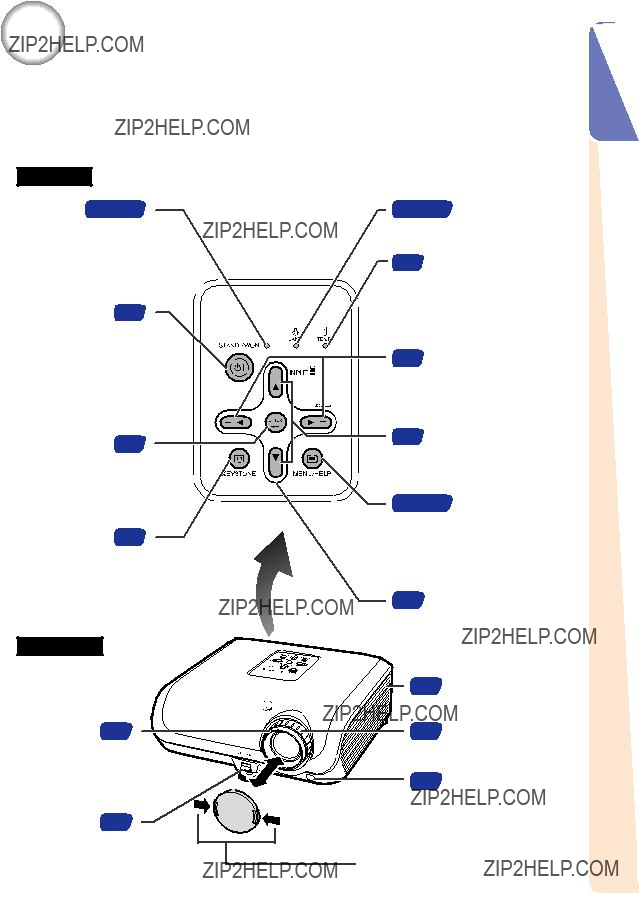
Part Names and Functions
Numbers in Zrefer to the main pages in this operation manual where the topic is explained.
Projector
Top View
Introduction
STANDBY/ON 27 button
For turning the power on and putting the projector into standby mode.
ENTER button 37
For setting items selected or adjusted on the menu.
KEYSTONE 31 button
For entering the Keystone Correction mode.
Front View
11

Part Names and Functions (Continued)
Numbers in Zrefer to the main pages in this operation manual where the topic is explained.
Rear View
Terminals Refer to ???INPUT Terminals and Connectable Main Equipment??? on page 21.
and component signals.
AUDIO OUTPUT 21 terminal
Audio output terminal of equipment connected to the
AUDIO INPUT terminal.
25OUTPUT (INPUT 1, 2) terminal
(Shared computer RGB and component signals output terminal for INPUT 1 and 2)
Terminal for connecting a monitor.
24 INPUT 3 terminal
Terminal for connect- ing video equipment with an
26
Terminal for controlling the projector using a computer.
Terminal for connecting video equipment.
Using the Kensington Lock
???This projector has a Kensington Security Standard connector for use with a Kensington MicroSaver Security System. Refer to the information that came with the system for instructions on how to use it to secure the projector.
12
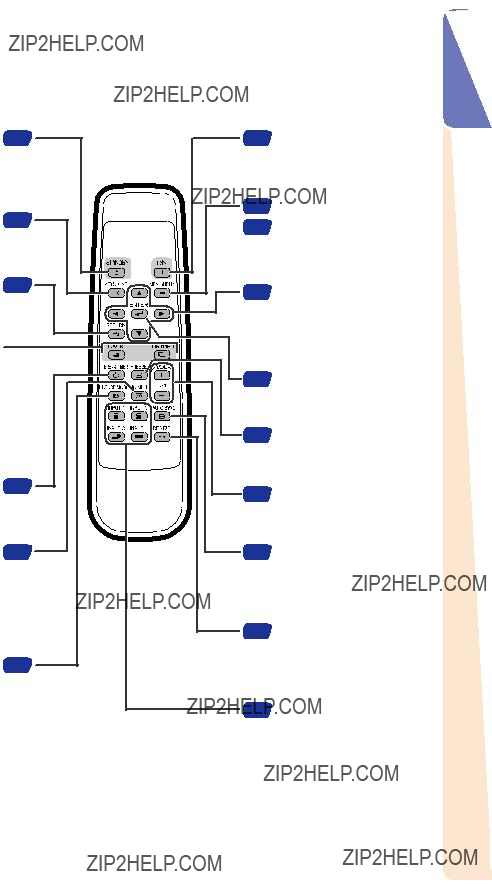
Numbers in Zrefer to the main pages in this operation manual where the topic is explained.
Introduction
during menu operations.
FORWARD/BACK buttons
Same function as the [Page Down] and [Page Up] keys on a computer keyboard when using the optional Remote Receiver
button
For selecting the appropriate picture.
27ON button
For turning the power on.
37MENU/HELP button
For displaying adjustment
46and setting screens, and help screen.
37Adjustment buttons (P/R/O/Q)
???For selecting menu items.
???For adjusting the Keystone Correction when in the Keystone Correction mode.
37ENTER button
For setting items selected or adjusted on the menu.
34FREEZE button
For freezing images.
30Volume buttons
For adjusting the speaker sound level.
34AUTO SYNC button
For automatically adjusting images when connected to a computer.
32RESIZE button
For switching the screen size (NORMAL, BORDER, etc.).
30INPUT 1, 2, 3 and 4 buttons
For switching to the respective input modes.
13

Part Names and Functions (Continued)
Inserting the Batteries
1 Press the P mark on the cover and slide it in the direction of the arrow.
2 Insert the batteries.
??? Insert the batteries making sure the polarities correctly match the m and n marks inside the battery compartment.
3 Attach the cover and slide it until it clicks into place.
Incorrect use of the batteries may cause them to leak or explode. Please follow the precautions below.
 Caution
Caution
???Danger of explosion if battery is incorrectly replaced. Replace only with the same or equivalent type.
???Insert the batteries making sure the polarities correctly match the m and n marks inside the battery compartment.
???Batteries of different types have different properties, therefore do not mix batteries of different types.
???Do not mix new and old batteries.
This may shorten the life of new batteries or may cause old batteries to leak.
???Remove the batteries from the remote control once they have run out, as leaving them in can cause them to leak.
Battery fluid from leaked batteries is harmful to skin, therefore ensure that you first wipe them and then remove them using a cloth.
???The batteries included with this projector may run down in a short period, depending on how they are kept. Be sure to replace them as soon as possible with new batteries.
???Remove the batteries from the remote control if you will not be using the remote control for a long time.
???Comply with the rules (ordinance) of each local government when disposing of
14

Usable Range
The remote control can be used to control the projector within the ranges shown in the illustra- tion.
 Note
Note
???The signal from the remote control can be re- flected off a screen for easy operation. How- ever, the effective distance of the signal may differ depending on the screen material.
When using the remote control
???Ensure that you do not drop, expose to mois- ture or high temperature.
???The remote control may malfunction under a fluorescent lamp. In this case, move the pro- jector away from the fluorescent lamp.
Remote control sensor
30??
Remote control signal transmitters
Remote control
Introduction
15
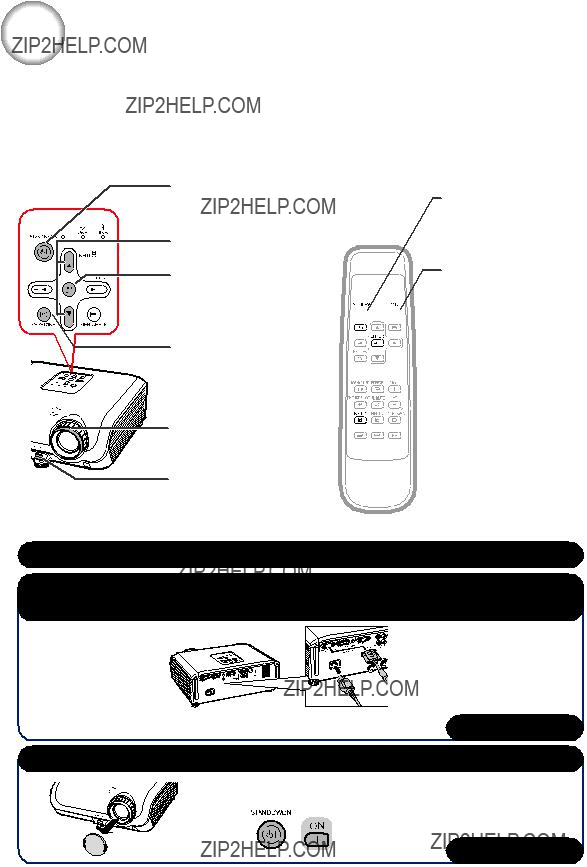
Quick Start
This section shows the basic operation (projector connecting with the computer). For details, see the page described below for each step.
Setup and Projection
In this section, connection of the projector and the computer is explained using one example.
8
3


 7
7
 4
4



 6
6
STANDBY button
ON button
KEYSTONE button
ENTER button
INPUT 1 button
2.Connect the projector to the computer and plug the power cord into the AC socket of the projector
16

4.Adjust the projected image with the Setup Guide
1After the projector turns on, the Setup Guide appears. (When ???Setup Guide??? is set to ???On???. n page 42)
2Follow the steps in the Setup Guide and adjust the focus, screen size, and height (angle).
3After adjusting the focus, height (angle) and screen size, press TENTER to finish the Setup Guide.
5.Turn the computer on
6.Select the INPUT mode
Select the ???INPUT 1??? using the INPUT button on the projector or C INPUT 1 on the remote
control.
On the On the remote
7. Correct trapezoidal distortion
Correcting trapezoidal distortion using the Keystone Correction. (Keystone Correction functions automatically on
On the projector
On the remote control
8. Turn the Power off
Press the STANDBY/ON button on the projector or the STANDBY button on the remote control, and then press the button again while the confirmation message is displayed, to put the projector into standby mode.
??? Unplug the power cord from the AC outlet after the cooling fan stops.
Start Quick
17
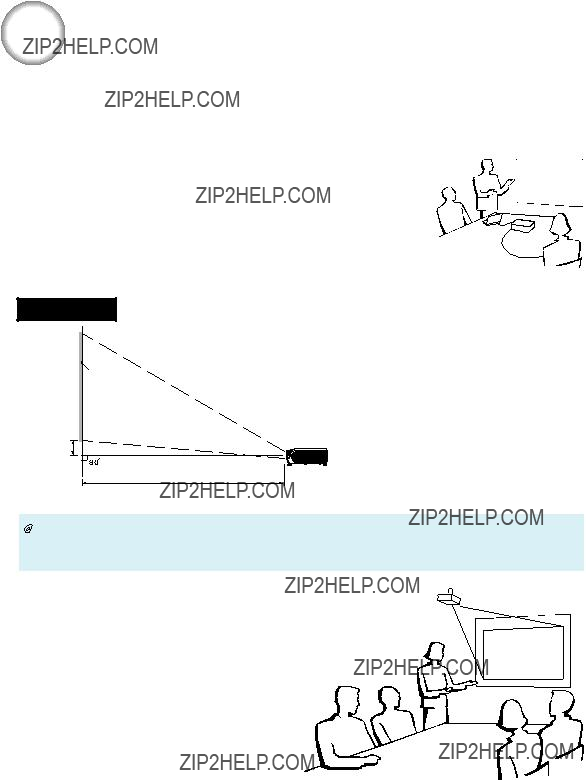
Setting up the Projector
Setting up the Projector
For optimal image quality, position the projector perpendicular to the screen with the projector???s feet flat and level. Doing so will eliminate the need for Keystone correction and provide the best image quality. (See page 31.)
Standard Setup (Front Projection)
???Place the projector at the required distance from the screen according to the desired picture size. (See page 20.)
Example of standard setup
Side View
Screen
H
Lens center
L
 Note
Note
??? Refer to page 20 for additional information concerning ???Screen Size and Projection Distance???.
???It is recommended that you use the optional Sharp
Dealer or Service Center to obtain the rec- ommended
???
???
???Invert the image by setting ???Ceiling + Front??? in ???PRJ Mode???. See page 42 for use of this function.
18
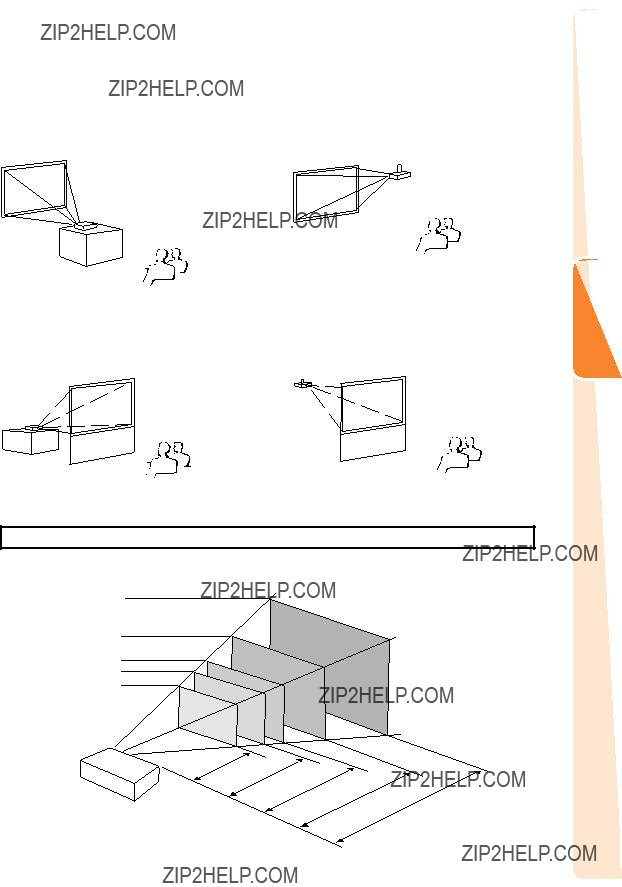
Projection (PRJ) Mode
The projector can use any of the 4 projection modes, shown in the diagram below. Select the mode most appropriate for the projection setting in use. (You can set the PRJ mode in
Menu item ??? ???Front???
???Table mounted, rear projection (with a translucent screen)
Menu item ??? ???Rear???
Menu item ??? ???Ceiling + Front???
???Ceiling mounted, rear projection (with a translucent screen)
Menu item ??? ???Ceiling + Rear???
Setup
Indication of the Projection Image Size and Projection Distance
Example: NORMAL Mode (4:3)
Picture Size
300"
240"??180"
200"
19

Setting up the Projector (Continued)
Screen Size and Projection Distance
NORMAL Mode (4:3)
STRETCH Mode (16:9)
 Note
Note
???Refer to page 18 concerning ???Projection distance (L)??? and ???Distance from the lens center to the bottom of the image (H)???.
???Allow a margin of error in the values in the diagrams above.
???Values with a minus
20

Connections
INPUT Terminals and Connectable Main Equipment
INPUT 1, 2 terminal
???Connecting the computer. (See page 23.)
???Connecting video equipment with compo- nent output terminal (DVD player, DTV decoder, DVD recorder with hard disc, etc.). (See page 24.)
AUDIO (INPUT 1, 2) terminal
Connecting an audio cable (Shared audio input terminal for INPUT 1 and 2). (See pages 23 and 24.)
Rear View
INPUT 3 terminal
Connecting video equipment with
Connecting the computer to control the projector. (See page 26.)
AUDIO OUTPUT terminal
Connecting to an amplifier or other audio equipment with an audio cable (commercially available) (Shared audio output terminal for INPUT 1, 2, 3 and 4).
Use an audio cable with ??3.5 mm minijack plug to connect to this terminal.
INPUT 4 terminal
Connecting video equipment without S- video output terminal. (See page 25.)
21

Samples of Cables for Connection
???For more details of connection and cables, refer to the operation manual of the connecting equipment.
???You may need other cables or connectors not listed below.
22

Connecting to a Computer
Before connecting, ensure that the power cord of the projector is unplugged from the AC outlet and turn off the devices to be connected. After making all connections, turn on the projector and then the other devices. When connecting a computer, ensure that it is the last device to be turned on after all the connections are made.
Ensure that you have read the operation manuals of the devices to be connected before making connections.
* ??3.5 mm stereo or mono audio cable (commercially available or available as Sharp service part QCNWGA038WJPZ)
RGB Cable
*When using the ??3.5 mm mono audio cable, the volume level will be half of when using the ??3.5 mm stereo audio cable.
Connections
 Note
Note
???See page 58 ???Computer Compatibility Chart??? for a list of computer signals compatible with the projec- tor. Use with computer signals other than those listed may cause some of the functions to not work.
???A Macintosh adaptor may be required for use with some Macintosh computers. Contact your near- est Macintosh Dealer.
???Depending on the computer you are using, an image may not be projected unless the computer???s external output port is switched on. (e.g. Press ???Fn??? and ???F5??? keys simultaneously when using a SHARP notebook computer). Refer to the specific instructions in your computer's operation manual to enable your computer???s external output port.
23
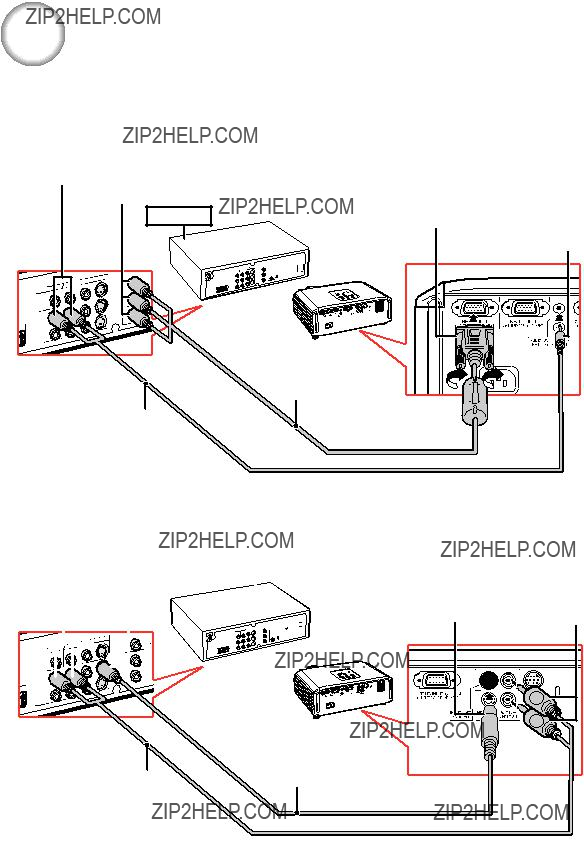
Connecting to Video Equipment
The projector is equipped with input terminals that support component,
The image quality is highest in the order of the component signal, the
When using a 3 RCA (Component) to
To audio output terminal
3 RCA (Component) to
??3.5 mm minijack to RCA audio cable (commercially available)
When using an
RCA audio cable (com-(commercially available) mercially available)
24

When using a composite video cable (INPUT4)
To audio output terminal
To video output terminal DVD, etc.
Composite video cable RCA audio cable (com-(commercially available) mercially available)
Connecting to a Monitor with RGB Input Terminal
You can display computer images on both the projector and a separate monitor using two sets of RGB cables.
Connections
 Note
Note
???RGB signals and Component signals can be output to the monitor.
???For this connection, another RGB cable (commercially available) is required.
25

Controlling the Projector by a Computer
When the
When connecting to a computer using an
Computer
To
* This adaptor is only supplied with
 Note
Note
???The
???See page 53 for connection of an
 Info
Info
???Do not connect the
???Do not connect or disconnect an
Connecting the Power
Cord
Plug the supplied power cord into the AC socket on the rear of the projector.
AC socket
26

Turning the Projector On/Off
Turning the Projector on
Note that the connections to external equip- ment and power outlet should be done be- fore performing the operations written be- low. (See pages 23 to 26.)
Remove the lens cap and press SSTANDBY/ON on the projector or fON on the remote control.
???When System Lock is set, the keycode input box appears. To cancel the keycode setting, input the keycode that you have already set. See page 44 for details.
 Note
Note
???About the Lamp Indicator
The lamp indicator illuminates to indicate the status of the lamp.
Green: The lamp is on.
Blinking in green: The lamp is warming up or shut- ting down.
Red: The lamp is shut down abnormally or the lamp should be replaced.
???When switching on the projector, a slight flickering of the image may be experienced within the first minute after the lamp has been illuminated. This is normal operation as the lamp???s control circuitry is stabilising the lamp output char- acteristics. It should not be regarded as faulty operation.
???If the projector is put into standby mode and immediately turned on again, the lamp may take some time to start pro- jection.
Turning the Power off (Putting the Projector into Standby Mode)
 Info
Info
???English is the factory default language. If you want to change the
 Lamp indicator
Lamp indicator
Power indicator
STANDBY/ON button


 STANDBY button
STANDBY button
R
 Info
Info
???Do not unplug the power cord during projection or cooling fan operation. This can cause dam- age due to rise in internal temperature, as the cooling fan also stops.
27

Image Projection
About the Setup Guide
After turning on the projector, the Setup Guide screen appears to assist you with projector setup.
Guidance items
1FOCUS
2HEIGHT ADJUST
3ZOOM
Press TENTER to exit the Setup Guide screen.
 Note
Note
??? The Setup Guide screen automatically high- lights the items in the following order:
However, you can adjust the focus, height (angle), or zoom regardless of the highlighted item.
???If you do not want to display the Setup Guide for the next time, set ???Menu??? - ???SCR - ADJ??? - ???Setup Guide??? to ???Off???. (See page 42.)
Setup Guide screen
STANDBY/ON button
ENTER button
Adjusting the Projected Image
1 Adjusting the Focus
You can adjust the focus with the focus ring on the projector.
Rotate the focus ring to adjust the fo- cus while watching the projected image.
2 Adjusting the Screen Size
You can adjust the screen size using the zoom ring on the projector.
Rotate the zoom ring to enlarge or shrink the screen size.
Zoom ring
Focus ring
28
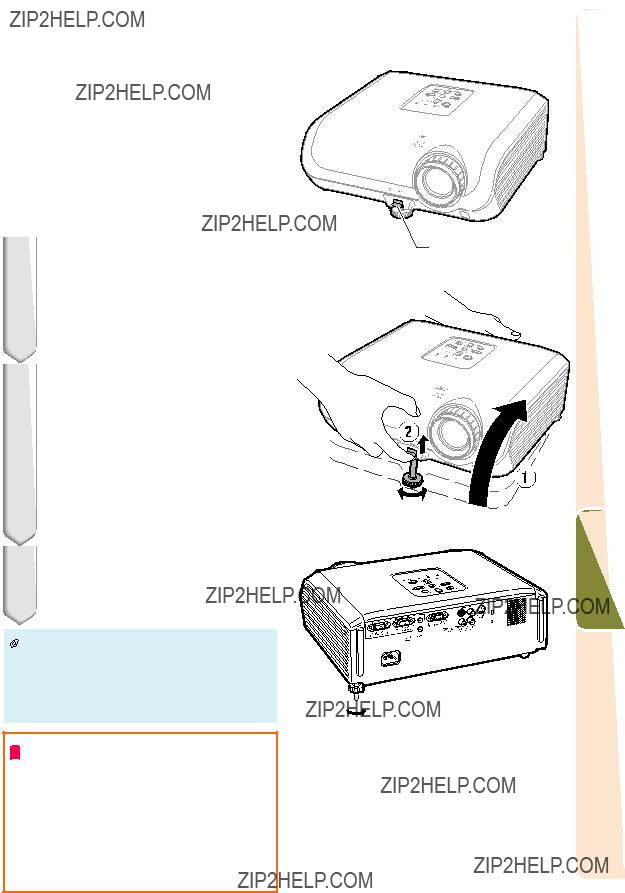
3 Adjusting the Height
The height of the projector can be ad- justed using the adjustment feet at the front and rear of the projector.
When the screen is above the projec- tor, the projection image can be made higher by adjusting the projector.
1 Lift the projector to adjust its height while lifting the HEIGHT ADJUST lever.
2 Remove your hands from the HEIGHT ADJUST lever of the pro- jector after its height has been finely adjusted.
???The angle of projection is adjustable up to 8 degrees from the surface on which the projector is placed.
3 Use the rear adjustment foot to make the projector level.
???The projector is adjustable ??1 degree from the standard position.
 Note
Note
???When adjusting the height of the projector, trapezoidal distortion occurs. Follow the pro- cedures in Keystone Correction to correct the distortion. (See pages 31 and 41.)
 Info
Info
???Do not apply too much pressure on the pro- jector when the front adjustment foot comes out.
???When lowering the projector, be careful not to get your fingers caught in the area between the adjustment foot and the projector.
???Hold the projector firmly while lifting or carry- ing.
???Do not hold by the lens area.
HEIGHT
ADJUST lever
Make small adjustments.
BasicOperation
 Rear adjustment foot
Rear adjustment foot
29
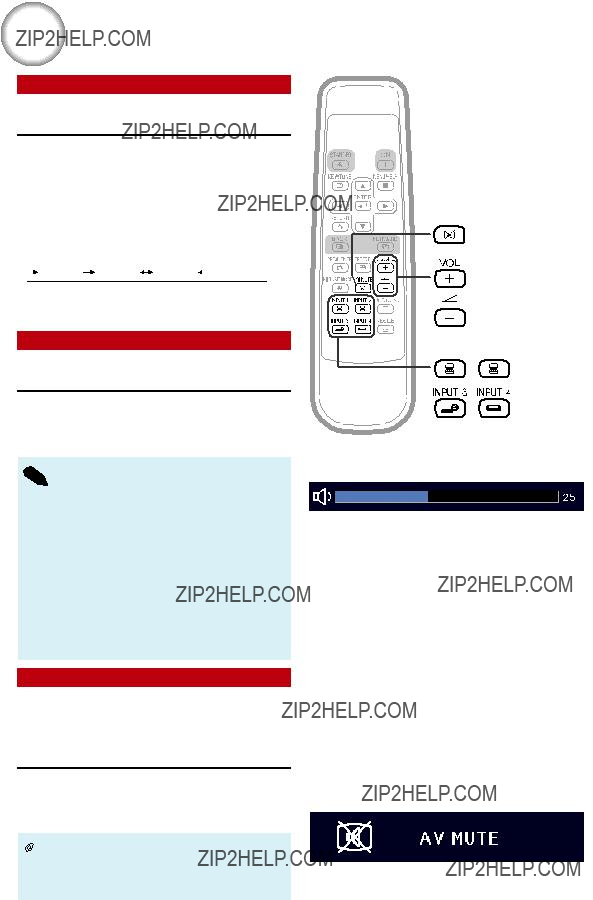
Image Projection (Continued)
Switching the Input Mode
Select the appropriate input mode for the connected equipment.
PressC INPUT 1, C INPUT 2, DINPUT 3 or EINPUT 4 on the remote control to select the input mode.
??? When pressing INPUT (P/R) on the projector, input mode switches in the following order:
 INPUT1 INPUT2 INPUT3
INPUT1 INPUT2 INPUT3  INPUT4
INPUT4
 .
.
???When ???Auto Search??? is set to ???On???, INPUT (P/ R) on the projector functions as the Auto Search buttons. (See page 43.)

 AV MUTE button
AV MUTE button
Volume buttons
Adjusting the Volume
Press K/L on the remote control or
???Pressing
???Pressing L/Q+ will raise the volume.
???When the projector is connected to external equipment, the volume level of the external equip- ment changes in accordance with the volume level of the projector. Set the projector???s volume to the lowest level when turning the projector on/ off or changing the input signal.
???When you do not want to output the sound from the projector???s speaker while the projector is con- nected to external equipment, set ???Speaker??? in



 INPUT buttons
INPUT buttons
Displaying the Black Screen and Turning off the Sound Temporarily
Press MAV MUTE on the remote con-
trol to temporarily display a black
 Note
Note
???Pressing MAV MUTE again will turn the projected image back on.
30

Correcting Trapezoidal
Distortion
When the image is projected either from the top or from the bottom towards the screen at an angle, the image becomes distorted trapezoidally.The function for correcting trapezoidal distortion is called Keystone Correction.
 Note
Note
???The Keystone Correction can be adjusted up to an angle of approximately ??13 degrees and the screen can also be set up to an angle of approximately ??13 degrees (when the resize mode is set to ???NORMAL??? (see page 32)).
1Press g KEYSTONE to enter the
Keystone Correction mode.
???You can also display the
play of the Keystone Correction mode with d KEYSTONE on the projector.
2Press P/Q or O/R to adjust the
Keystone Correction.
???You can also adjust the Keystone Cor- rection using the adjustment buttons on the projector.
 Note
Note
???Press l RETURN while the
3 Press g KEYSTONE.
???The
???You can also use d KEYSTONE on the projector.
When using
???The projector automatically detects tilt and the AUTO KEYSTONE feature automatically cor- rects trapezoidal distortion.


 KEYSTONE button
KEYSTONE button
Adjustment buttons (P/R/O/Q)

 RETURN button
RETURN button
Shrinks upper side.
(Move the slide bar in the + direction.)
Shrinks lower side.
(Move the slide bar in the - direction.)
 Info
Info
???While adjusting the image using Keystone Correction, straight lines and the edges of the image may appear jagged.
 Note
Note
???Automatic Keystone Correction may not work well in some cases, such as when the screen is leaning, temperature is extremely high or low, or zoom is at maximum or mini- mum. In these cases, fine adjust the Keystone Correction following steps 1 to 3.
???You can select ???On??? or ???Off??? for the Auto Keystone Correc- tion mode. (See page 41.)
BasicOperation
31

Image Projection (Continued)
Resize Mode
This function allows you to modify or customize the resize mode to enhance the input image. De- pending on the input signal, you can choose ???NORMAL???, ???BORDER??? or ???STRETCH??? image.
*Mode for projecting an image with the original aspect ratio without cutting any portions.
: Cutout area on which images cannot be projected.
32

VIDEO
??? ???STRETCH??? is fixed when 540P, 720P or 1080I signals are entered.
* Mode for projecting an image with the original aspect ratio without cutting any portions.


 : Cutout area on which images cannot be projected.
: Cutout area on which images cannot be projected.


 : Area on which the image is not included in the original signals.
: Area on which the image is not included in the original signals.
33
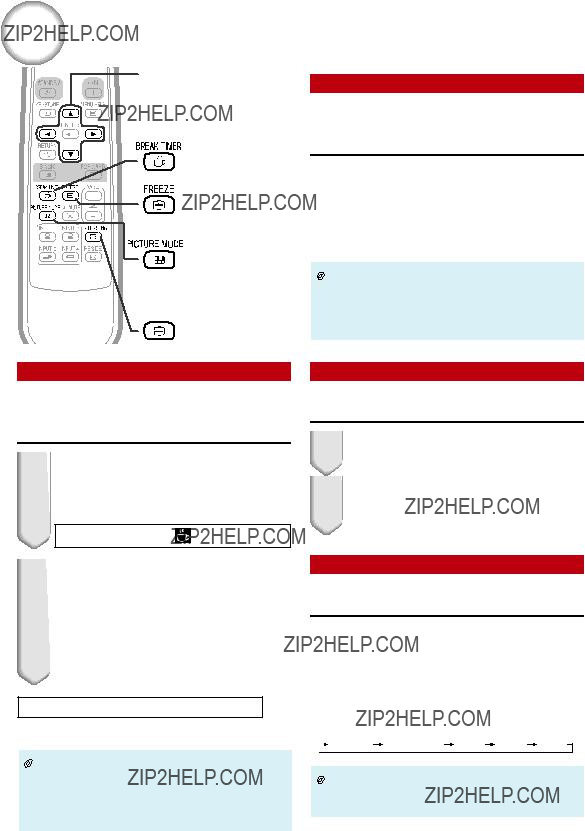
Operating with the Remote Control
Adjustment buttons (P/R/O/Q)
BREAK TIMER button
FREEZE button
PICTURE MODE button


 AUTO SYNC button
AUTO SYNC button
Auto Sync
(Auto Sync Adjustment)
Auto Sync function works when detect- ing input signal after the projector turns on.
Press FAUTO SYNC to manually ad- just with Auto Sync function.
 Note
Note
???When the optimum image cannot be achieved with Auto Sync adjustment, use the help menu for manual adjustments. (See page 46.)
Displaying and Setting the
Break Timer
1 Press k BREAK TIMER.
???The timer starts to count down from 5 minutes.
Freezing a Moving Image
1 Press NFREEZE.
??? The projected image is frozen.
2 Press NFREEZE again to return to the moving image from the cur- rently connected device.
Canceling the break time display function
Press k BREAK TIMER.
 Note
Note
???Break Timer does not function while the pro- jector is operating the ???Auto Sync???, ???FREEZE??? or ???AV MUTE??? functions.
Selecting the Picture Mode
You can select the appropriate picture mode for the projected image, such as movie or video game.
Press GPICTURE MODE.
??? When pressing GPICTURE MODE, the picture mode changes in the following order:
 Standard Presentation Movie Game sRGB *
Standard Presentation Movie Game sRGB *
 Note
Note
???See page 39 for details on the picture mode.
*???sRGB??? is displayed only when RGB signal is input.
34

Menu Items
The following shows the items that can be set in the projector.
35
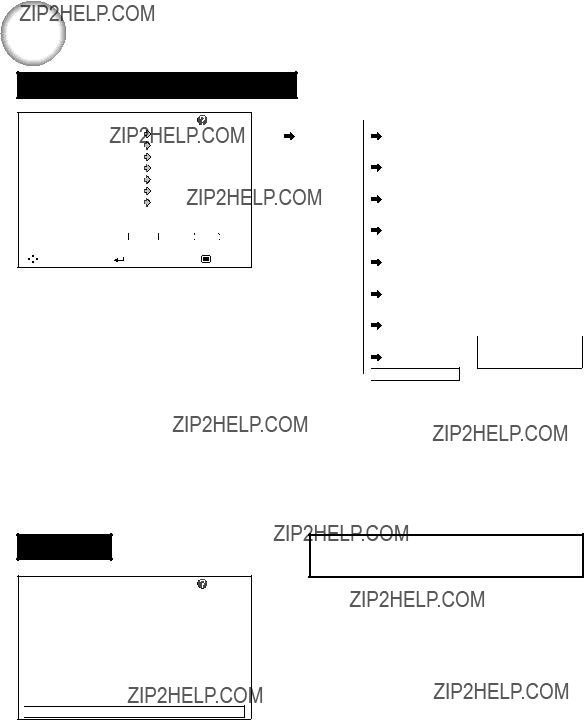
Menu Items (Continued)
???Projection adjustment
System Lock
???Help??? menu
 There is no picture or audio
There is no picture or audio
 Vertical stripes or flickering image appear
Vertical stripes or flickering image appear
 Data image is not centered
Data image is not centered
 Color is faded or poor
Color is faded or poor
 Picture is dark
Picture is dark
 The image is distorted
The image is distorted
 Reset all adjustments to default settings
Reset all adjustments to default settings

 SEL.
SEL.  ENTER
ENTER  END
END
 Lamp Timer(Life)
Lamp Timer(Life)
 Page 44
Page 44
The items you can set with ???Help??? menu
???Help??? menu n Page 46
???Vertical stripes or flickering image appear Auto Sync
Adjust vertical noise Adjust horizontal noise
???Data image is not centered
Auto Sync
??? Color is faded or poor INPUT 1 or INPUT 2
Signal type: Auto/RGB/Component INPUT 3 or INPUT 4
Video System: A u t o / P A L / S E C A M / NTSC3.58/NTSC4.43/PAL-
*The selectable items vary depending on the in- put signal and the selected input mode.
36
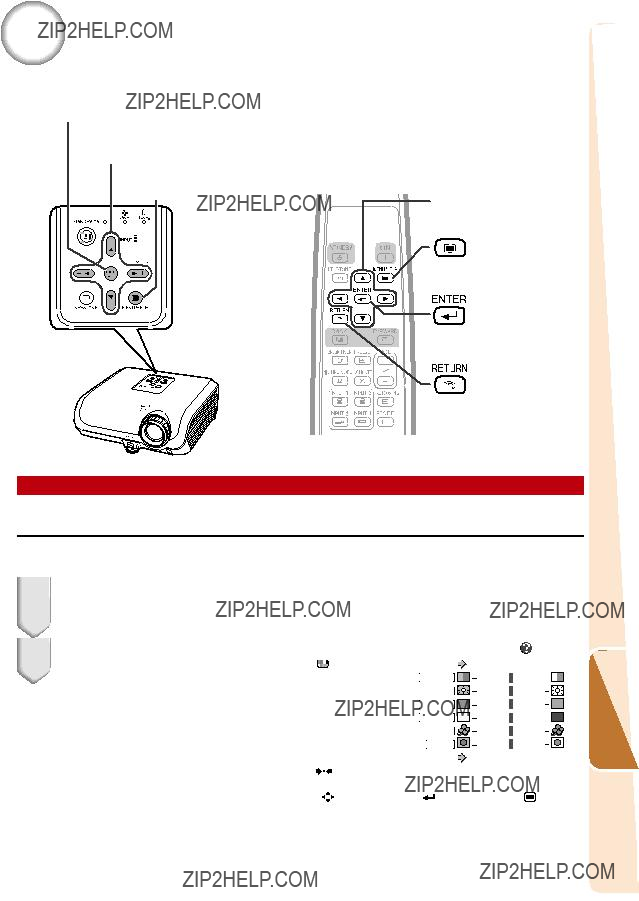
Using the Menu Screen
ENTER button
Adjustment buttons (P/R/O/Q)
MENU/HELP button
Adjustment buttons (P/R/O/Q)


 MENU/HELP button
MENU/HELP button
ENTER button
RETURN button
??? Press lRETURN to return to the previous screen when the menu is displayed.
Menu Selections (Adjustments)
Example: Adjusting ???Bright???.
??? This operation can also be performed by using the buttons on the projector.
1 Press BMENU.
???The ???Picture??? menu screen for the se- lected input mode is displayed.
2 Press Qor Oand select ???Picture??? to adjust.
Example: ???Picture??? screen menu for INPUT 1 (RGB) mode
Menu item
37

Using the Menu Screen (Continued)
3 Press P or R and select ???Bright??? to adjust.
??? The selected item is highlighted.
To adjust the projected image while watching it
Press hENTER.
???The selected item (e.g. ???Bright???) is dis- played by itself at the bottom of the screen.
???When pressing Por R, the following item (???Red??? after ???Bright???) will be displayed.
 Note
Note
???Press hENTER again to return to the previous screen.
4 Press O or Q to adjust the item selected.
??? The adjustment is stored.
5 Press BMENU/HELP.
??? The menu screen will disappear.
 Note
Note
???Menu buttons do not function while the projector is operating the ???Auto Sync???, ???Break Time???, ???FREEZE???, or ???AV MUTE??? functions.
38

Picture Adjustment (???Picture??? menu)
1Selecting the Picture Mode
??????sRGB??? is displayed only when RGB signal is input.
???You can set or adjust each item in the ???Picture??? menu to your preference. Any changes you make are retained in memory.
 Note
Note
 Info
Info
???When ???sRGB??? is selected, the projected image may become dark, but this does not indicate a malfunction.
39

Picture Adjustment (???Picture??? menu) (Continued)
Menu operation n Page 37
2Adjusting the Image
*1 Not adjustable/selectable when selecting ???sRGB???.
*2 Not displayed in the RGB input mode.
*3 ???Tone??? will appear on the menu screen only when PAL or SECAM signals are input (including when forcibly changed to those input signals). There is basically no need to adjust ???Tone???, but you can adjust the picture tone with this adjustment when inputting PAL or SECAM signals .
 Note
Note
??????Bright Boost??? and ???CLR Temp??? cannot be set when ???sRGB??? is selected.
???To reset all adjustment items, select ???Reset??? and press hENTER.
4Progressive
*The film source is a digital video recording with the original encoded as is at 24 frames/second. The projector can convert this film source to progres- sive video at 60 frames/second with NTSC and PAL60Hz or at 50 frames/second with PAL50Hz and SECAM to play back a
 Note
Note
???In NTSC or PAL60Hz, even if the 3D Progres- sive mode has been set, the
???When the image is blurred or noisy, switch to the optimal mode.
???When using progressive inputs, inputs are di- rectly displayed so that 2D Progressive, 3D Progressive and Film Mode cannot be se- lected.
3Adjusting the Color
Temperature
 Note
Note
???Values on ???CLR Temp??? are only for general standard purposes.
40
5Lamp Setting
 Note
Note
???When ???Lamp Setting??? is set to ???Eco+Quiet???, the power consumption will decrease and the lamp life will extend. (Projection brightness decreases approximately 13%.)

Adjusting the Projected Image (???SCR - ADJ??? menu)
Menu operation n Page 37
*???Auto Keystone??? can be operated only when using
1Setting the Resize Mode
 Note
Note
???For details of the Resize mode, see pages 32 and 33.
???You can also press HRESIZE on the remote control to set the resize mode. (See page 32.)
2Adjusting the Image
Position
You can move the projected image vertically.
3Keystone Correction
When the image is projected either from the top or from the bottom towards the screen at an angle, the image becomes distorted trapezoidally. The function for correcting trap- ezoidal distortion is called Keystone Correction.
a When using
For Auto Keystone Correction
Set ???Auto Keystone??? on the ???SCR - ADJ??? menu to ???On???.
For Manual Keystone Correction
Set ???Auto Keystone??? on the ???SCR - ADJ??? menu to ???Off???, select ???Keystone???, and then adjust with the slide bar.
Manual Correction
Q or P button O or R button
 Note
Note
???You cannot set this item when ???Resize??? is set to ???Normal???.
a When using
Select ???Keystone??? on the
See page 31 for details of Keystone Correction.
 Note
Note
???The Keystone Correction can be adjusted up to an angle of approximately ??13 degrees with the ???Auto Keystone??? and up to an angle of approximately ??13 degrees with the manual ???Keystone??? (when ???Resize??? is set to ???Normal???).
41

Adjusting the Projected Image (???SCR - ADJ??? menu) (Continued)
4Setting
Display
5Selecting the Background
Image
6Selecting the Setup
Guide
8Selecting the
Display Language
The projector can switch the
English
Deutsch
Espa??ol
Nederlands
Fran??ais
Italiano
Svenska
Portugu??s
42

1Auto Search Function
This function automatically searches for and switches to the input mode in which signals are being received, when the projector is turned on, or when the INPUT button is pressed.
 Note
Note
When ???Auto Search??? is set to ???On???
???If two or more input signals are found, the pro- jector selects the input source in the order of INPUT 1 n INPUT 2 n INPUT 3 n INPUT 4 when you press INPUT (P/R) on the projec- tor.
???While ???Auto Search??? is set to ???On???, press CINPUT 1,CINPUT 2, DINPUT 3 or EINPUT 4 on the remote control to select an input mode other than the input mode se- lected by the projector.
3Auto Power Off
 Note
Note
???When the Auto Power Off function is set to ???On???, 5 minutes before the projector enters standby mode, the message ???Enter STANDBY mode in X min.??? will appear on the screen to indicate the remaining minutes.
2Auto Sync (Auto Sync
Adjustment)
 Note
Note
???Auto Sync adjustment is also performed by pressing FAUTO SYNC on the remote con- trol.
???The Auto Sync adjustment may take some time to complete, depending on the image of the computer connected to the projector.
???When the optimum image cannot be achieved with Auto Sync adjustment, use manual ad- justments. (See page 46.)
4Setting the Confirmation
Sound (System Sound)
5Speaker Setting
43
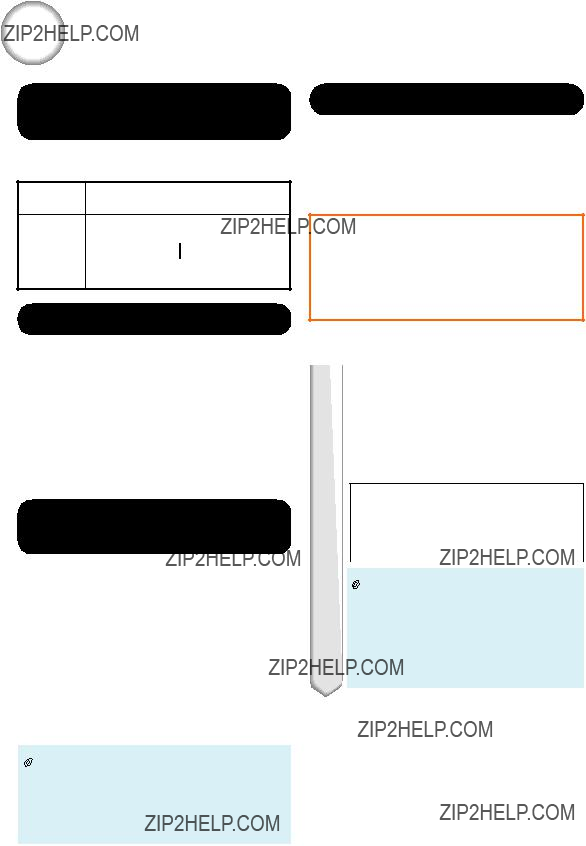
Adjusting the Projector Function (???PRJ - ADJ??? menu) (Continued)
6Selecting the Transmission Speed
Make sure that both the projector and computer are set for the same baud rate.
Selectable
Menu operation n Page 37
8System Lock Function
This function prevents unauthorized use of the projector. Once this function is activated, users must enter the correct keycode each time the projector is turned on. We suggest you record the keycode in a safe place where only au-
items
Description
thorized users have access.
9600bps Transmission speed is slow.
P
R
115200bps Transmission speed is rapid.
7Fan Mode Setting
This function changes the fan rotation speed.
When ???Fan Mode??? is set to ???High???, the fan rotation speeds up, and the fan noise becomes louder.
9Checking the Lamp Life
Status
You can confirm the cumulative lamp usage time and the remaining lamp life (percentage).
 Info
Info
???If you lose or forget your keycode, contact your nearest Sharp Authorized Projector Dealer or Service Center (see page 61). Even if the prod- uct warranty is valid, the keycode reset will incur a charge.
aSetting/Changing the keycode
1Press the 4 buttons on the remote control or on the projector to en- ter the preset keycode in ???Old Code???.
???When setting the keycode for the first time, press R on the projector for four times.
 Note
Note
???If you input a wrong keycode, the cursor returns to the first point of the ???Old Code???.
???The preset keycode is 4 R buttons on the projector. When you press the Rbut- ton four times, the keycord input screen disappears.
 Note
Note
???It is recommended that the lamp be changed when the remaining lamp life becomes 5%.
???The lamp life may vary depending on the us- age condition.
44

??? B MENU/HELP
???System lock function recognizes each button on the remote control or on the
projector as an individual button, even ??? The keylock function does not affect the op-
 Note
Note
To cancel the keycode that you have already set
???Press Ron the projector for four times in steps 2 and 3 above.
When the System Lock is set
???When System Lock is set, the keycode input screen appears after the power is turned on. When it appears, enter the right keycode to start projection.
Input screen for keycode
 Info
Info
???Keylock does not function while the projector is: displaying the ???Setup Guide??? or ???Menu??? screens, in standby mode, warming up, changing input signals, operating ???Auto Sync??? function, in ???FREEZE??? mode or on the ???Sys- tem Lock??? screen during warming up.
45

Troubleshooting with ???Help??? menu
This function advises you to solve the problems during usage.
Adjustment buttons (P/R/O/Q)
Utilizing ???Help??? menu functions


 MENU/HELP button
MENU/HELP button
ENTER button
Example: When image flickering appears
Operation to solve image flickering when pro- jecting the computer RGB signal.
1
2
3
Press BMENU/HELP.
Press Oor Qto select ???Help???, then press hENTER.
Press P or R to select ???Vertical stripes or flickering image ap- pears??? on Help menu, then press hENTER.
 There is no picture or audio
There is no picture or audio
 Vertical stripes or flickering image appear
Vertical stripes or flickering image appear
 Data image is not centered
Data image is not centered
 Color is faded or poor
Color is faded or poor
 Picture is dark
Picture is dark
 The image is distorted
The image is distorted
 Reset all adjustments to default settings
Reset all adjustments to default settings
 Vertical stripes or flickering image appear
Vertical stripes or flickering image appear
Initiate ???Auto Sync??? Adjustments.
If there is no change after performing "Auto Sync" adjustments, adjust the following items.
Adjust vertical noise
Adjust horizontal noise
 Reset the 2 items above
Reset the 2 items above
 Return
Return
Cur. sig. freq: H 43 kHz / V 60 Hz
4 Select ???Initiate ???Auto Sync??? Ad-
justments???, then press hENTER.
5 If the image is not improved, se- lect ???Adjust horizontal noise.???, then press hENTER.
 Note
Note
???You can adjust the items with check marks (???).
???The items in the ???Help??? menu change, de- pending on the input signal or setting that you have selected.
???If the problem is not solved, refer to ???Troubleshooting???. (see pages 59 and 60)
???When selecting ???sRGB??? in "Picture Mode???, the item ???Color is faded or poor??? is not displayed. This means you cannot change input signal types.
46
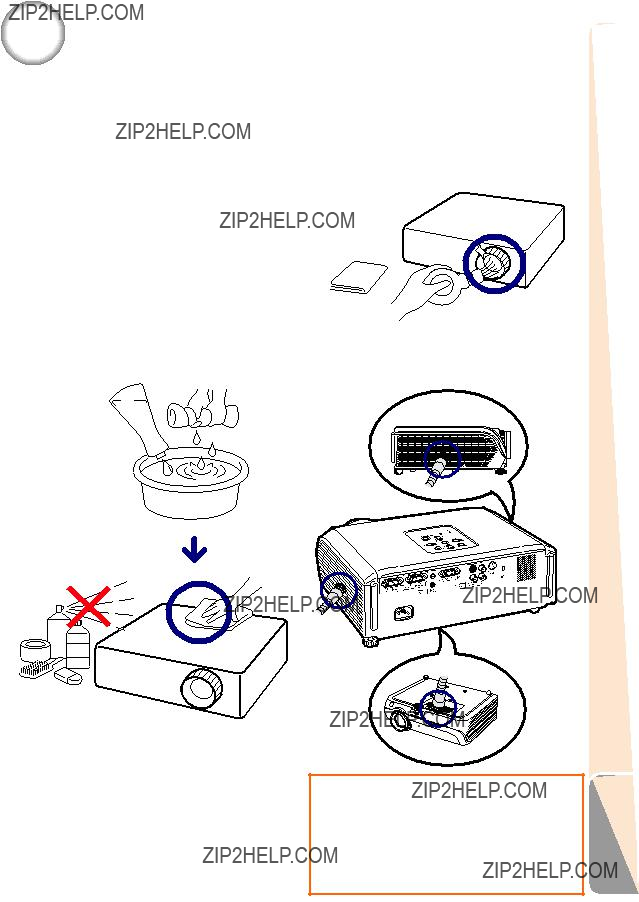
Maintenance
Cleaning the projector
???Ensure that you have unplugged the power cord before cleaning the projector.
???The cabinet as well as the operation panel is made of plastic. Avoid using benzene or thinner, as these can damage the finish on the cabinet.
???Do not use volatile agents such as insecticides on the projector.
Do not attach rubber or plastic items to the projector for long periods.
The effects of some of the agents in the plastic may cause damage to the quality or finish of the projector.
???Wipe off dirt gently with a soft flannel cloth.
???When the dirt is hard to remove, soak a cloth in a mild detergent diluted with water, wring the cloth well and then wipe the projector.
Strong cleaning detergents may discolor, warp or damage the coating on the projector. Make sure to test on a small, inconspicuous area on the projector before use.
Cleaning the lens
???Use a commercially available blower or lens cleaning paper (for glasses and camera lenses) for cleaning the lens. Do not use any liquid type cleaning agents, as they may wear off the coating film on the surface of the lens.
???As the surface of the lens can easily get damaged, be sure not to scrape or hit the lens.
Cleaning the exhaust and intake vents
???Use a vacuum cleaner to clean dust from the exhaust vent and the intake vent.
Mild detergent diluted with water
Wax Thinner
 Info
Info
??? If you want to clean the air vents during pro- jector operation, be sure to press S STANDBY/ON on the projector or eSTANDBY on the remote control and put the projector into standby mode. After the cooling fan has stopped, clean the vents.
Appendix
47

Maintenance Indicators
???The warning lights (power indicator, lamp indicator and temperature warning indicator) on the projector indicate problems inside the projector.
???If a problem occurs, either the temperature warning indicator or the lamp indicator will illuminate red, and the projector will enter standby mode. After the projector has entered standby mode, follow the procedures given below.
Top View
 Temperature warning indicator
Temperature warning indicator
Lamp indicator
Power indicator
About the temperature warning indicator
If the temperature inside the projector increases, due to blockage of the air vents, or the setting location, ??? ??? will illuminate in the lower left corner of the picture. If the temperature keeps on rising, the lamp will turn off and the temperature warning indicator will blink, the cooling fan will run, and then the projec- tor will enter standby mode. After ???
??? will illuminate in the lower left corner of the picture. If the temperature keeps on rising, the lamp will turn off and the temperature warning indicator will blink, the cooling fan will run, and then the projec- tor will enter standby mode. After ??? ??? appears, be sure to perform the measures described on page
??? appears, be sure to perform the measures described on page
49.
About the lamp indicator
???When the remaining lamp life becomes 5% or less,  (yellow) and ???Change The Lamp??? will be displayed on the screen. When the percentage becomes 0%, it will change to
(yellow) and ???Change The Lamp??? will be displayed on the screen. When the percentage becomes 0%, it will change to  (red), the lamp will automatically turn off and then the projector will automatically enter standby mode. At this time, the lamp indicator will illuminate in red.
(red), the lamp will automatically turn off and then the projector will automatically enter standby mode. At this time, the lamp indicator will illuminate in red.
???If you try to turn on the projector a fourth time without replacing the lamp, the projector will not turn on.
Indicators on the Projector
48
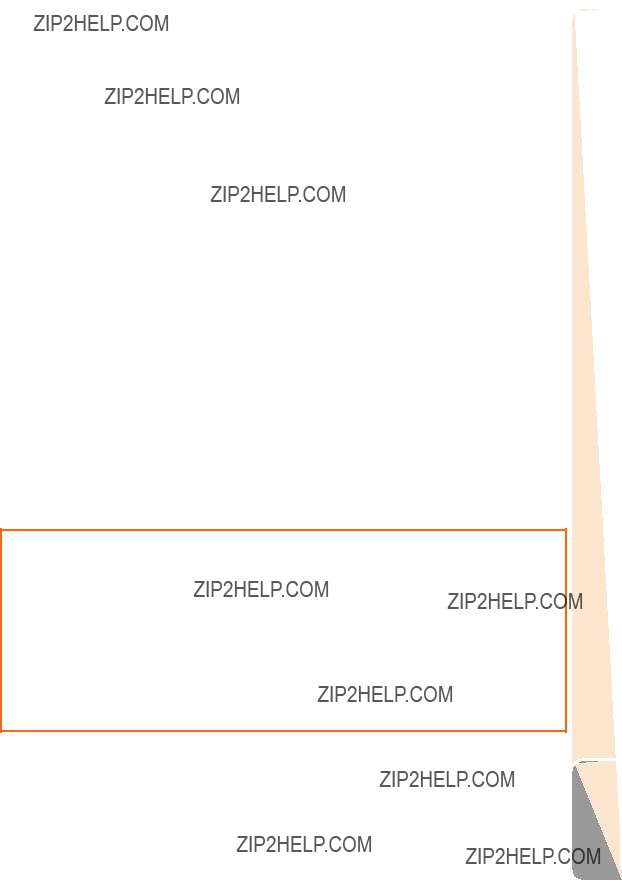
 Info
Info
???If the temperature warning indicator illuminates, and the projector enters standby mode, follow the possible solutions above and then wait until the projector has cooled down completely before plug- ging in the power cord and turning the power back on. (At least 10 minutes.)
???If the power is turned off for a brief moment due to power outage or some other cause while using the projector, and the power supply recovers immediately after that, the lamp indicator will illumi- nate in red and the lamp may not be lit. In this case, unplug the power cord from the AC outlet, replace the power cord in the AC outlet and then turn the power on again.
???The cooling fan keeps the internal temperature of the projector constant and this function is con- trolled automatically. The sound of the cooling fan may change during operation because the fan speed may change and this is not a malfunction.
???Do not unplug the power cord after the projector has entered standby mode and while the cooling fan is running. The cooling fan runs for about 90 seconds.
Appendix
49

Regarding the Lamp
Lamp
???It is recommended that the lamp (sold separately) be replaced when the remaining lamp life becomes 5% or less, or when you notice a significant deterioration in the picture and color quality. The lamp life (percentage) can be checked with the
???Purchase a replacement lamp of type
IMPORTANT NOTE TO U.S. CUSTOMERS:
The lamp included with this projector is backed by a
Hg LAMP CONTAINS MERCURY For State Lamp Disposal
Caution Concerning the Lamp
???This projector utilizes a pressurized mercury lamp. A loud sound may indicate lamp failure. Lamp failure can be attributed to numerous sources such as: excessive shock, improper cooling, surface scratches or deterioration of the lamp due to a lapse of usage time.
The period of time up to failure largely varies depending on the individual lamp and/or the condition and the frequency of use. It is important to note that failure can often result in the bulb cracking.
???When the lamp replacement indicator and
???Should the lamp break, there is also a possibility that glass particles may spread inside of the projector. In such a case, it is recommended you contact your nearest Sharp Authorized Projector Dealer or Service Center to assure safe operation.
???Should the lamp break, the glass particles may spread inside the lamp cage or gas contained in the lamp may be vented into the room from the exhaust vent. Because the gas in this lamp includes mercury, ventilate the room well if the lamp breaks and avoid all exposure to the released gas. In case of exposure to the gas, consult a doctor as soon as possible.
Replacing the Lamp
 Caution
Caution
???Do not remove the lamp unit from the projector right after use. The lamp will be very hot and may cause burn or injury.
???Carefully change the lamp by following the instructions described in this section. * If you wish, you may have the lamp replaced at your nearest Sharp Authorized Projector Dealer or Service Center.
*If the new lamp does not light after replacement, take your projector to the nearest Sharp Authorized Projector Dealer or Service Center for repair.
50

Removing and Installing the
Lamp Unit
 Warning!
Warning!
???Do not remove the lamp unit from the projec- tor right after use. The lamp and parts around the lamp will be very hot and may cause burns or injury.
Optional accessory
Lamp unit
(for
 Info
Info
???Make sure that you remove the lamp unit by the handle. Do not touch the glass surface of the lamp unit or the inside of the projector.
???To avoid injury to yourself and damage to the lamp, be sure to carefully follow the steps below.
???Do not loosen other screws except for the lamp unit cover and lamp unit.
1Press SSTANDBY/ON on the pro- jector or eSTANDBY on the re- mote control to put the projector into standby mode.
???Wait until the cooling fan stops.
2Disconnect the power cord.
???Unplug the power cord from the AC socket.
???Leave the lamp until it has fully cooled down (about 1 hour).
3Remove the lamp unit cover.
???Turn the projector over. Loosen the user service screw (1) that secures the lamp unit cover. Remove the lamp unit cover (2).
STANDBY/ON button
AC socket
1 

2
User service screw (for lamp unit cover)
Appendix
51

Regarding the Lamp (Continued)
5
6
Insert the new lamp unit.
???Press the lamp unit firmly into the lamp unit compartment. Fasten the securing screws.
Replace the lamp unit cover.
???Align the tab on the lamp unit cover (1)and place it while pressing the tab (2) to close it. Then tighten the user ser- vice screw to secure the lamp unit cover.
 Info
Info
???If the lamp unit and lamp unit cover are not correctly installed, the power will not turn on, even if the power cord is con- nected to the projector.
Securing screws
2
1
Resetting the Lamp Timer
Reset the lamp timer after replacing the lamp.
1 Connect the power cord.
??? Plug the power cord into the AC socket of the projector.
2 Reset the lamp timer.
??? While simultaneously holding down UMENU/HELP, TENTER and R on the projector, press SSTANDBY/ON on the projector.
??????LAMP 0000H??? is displayed, indicating that the lamp timer is reset.
STANDBY/ON button
ENTER button
MENU/HELP button
R button
52

Connecting Pin Assignments
 Note
Note
???Depending on the controlling device used, it may be necessary to connect Pin 4 and Pin 6 on the controlling device (e.g. computer).
Appendix

Computer control
A computer can be used to control the projector by connecting an
Communication conditions
Set the serial port settings of the computer to match that of the table.
* Set the projector's baud rate to the same rate as used by the computer.
Basic format
Commands from the computer are sent in the following order: command, parameter, and return code. After the projector processes the command from the computer, it sends a response code to the computer.
Command format
 Info
Info
???When controlling the projector using
???When more than one code is being sent, send each command only after the response code for the previous command from the projector is verified.
??????POWR??????? ???TABN _ _ _ 1??? ???TLPS _ _ _ 1??? ???TPOW _ _ _ 1??? ???TLPN _ _ _ 1??? ???TLTT _ _ _ 1???
???TLTL _ _ _ 1??? ???TNAM _ _ _ 1??? ???MNRD _ _ _ 1??? ???PJN0 _ _ _ 1??? When the projector receives a command shown above:
*The
*The ???Auto Power Off??? timer will not be reset.
 Note
Note
???If an underbar (_) appears in the parameter column, enter a space.
???If an asterisk (*) appears in the parameter column, enter a value in the range indicated in brackets
under Control Contents.
*1 For setting the projector name, send the commands in the order of PJN1, PJN2 and PJN3. *2 Parameters of CLR Temp settings are as follows.
54

Commands
Appendix
55

56

Appendix
57

Computer Compatibility Chart
Computer
The following is a list of modes that conform to VESA. However, this projector supports other signals that are not VESA standards.
 Note
Note
???When this projector receives 640K350 VESA format VGA signals, ???640K400??? appears on the screen.
???Optimum image quality will be achieved by matching your computer???s output resolution to the projector???s native resolution. (1024 x 768 for the
58

Troubleshooting
Appendix
59

Troubleshooting (Continued)
This unit is equipped with a microprocessor. Its performance could be adversely affected by incorrect operation or interference. If this should happen, unplug the Unit and plug it in again after more than 5 minutes.
60

For SHARP Assistance
If you encounter any problems during setup or operation of this projector, first refer to the ???Troubleshooting??? section on pages 59 and 60. If this operation manual does not answer your question, please contact the SHARP Service departments listed below.
Appendix
61

Specifications
As a part of policy of continuous improvement, SHARP reserves the right to make design and specification changes for product improvement without prior notice. The performance specifica- tion figures indicated are nominal values of production units. There may be some deviations from these values in individual units.
62

Dimensions
Units: inches (mm)
12 13/32 (315)
63

64
